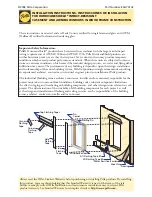
1. About the
type of clothes
to be treated
The
Driron
can be used for all kinds of everyday clothes, household
linen (sheets, towels, kitchen cloths, etc.) and Smalls (socks, underwear,
etc.).
The
Driron
can treat fabrics made of all kinds of fibres, but when the
fibres are 100% synthetic, we recommend you follow the manufacturer’s
recommendations for drying. In any case, position them as far away
as possible from the air outlet grille at the bottom. Given that this type
of synthetic fabric does not crease, the best place for drying them is
inside the top basket.
Clothes made of leather, suede, plastic, fur and, in general, clothes
that may be damaged by damp and heat must not be treated in the
Driron.
For this type of garment, use only the airing and deodorisation
programmes.
Take particular care with light knitwear, which should never be hung
for drying, as it stretches easily. Given that these clothes do not normally
crease, they can be placed in the top basket.
When the Tenter clip is placed on shirts made of corduroy or velvet,
we recommend you hang the garments inside out to prevent the clip
from marking the shirt. The same applies when hanging up corduroy
or velvet trousers.
The best way of ironing the garments is not to crease them too much
during the washing-spinning cycle. We recommend the following:
• Do not fill the washing machine to excess.
• Do not spin clothes at more than 900 rpm.
• Hang the garments in the
Driron
as soon as possible after they
have been washed.
With the Ironing and drying programmes
(programmes 1 and 2),
clothes
need to be sufficiently damp at the beginning of the cycle. The
Driron
uses the damp of the garments for the ironing process. This is another
reason for not spinning clothes at more than 900 rpm. They would not
be sufficiently damp.
Make sure the clothes are not pressed against each other (wardrobe
too full) as this may hinder the ironing process. The more laid out and
flat the clothes are in the wardrobe, the better the result.
2. To make it
easier to iron
garments
– 78 –
Chapter VI
- PRACTICAL TIPS



































